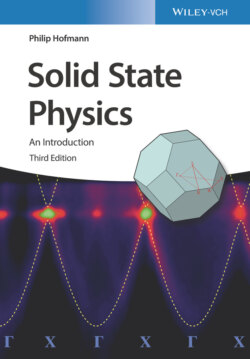Читать книгу Solid State Physics - Philip Hofmann - Страница 38
2.2 Ionic Bonding
ОглавлениеIonic bonding involves the transfer of electrons from an electropositive atom to an electronegative atom. The bonding force is the Coulomb attraction between the two resulting ions. Turning the atoms into ions usually costs some energy. In the case of NaCl, the ionization energy of Na is 5.1 eV and the electron affinity of Cl is 3.6 eV. The net energy cost for creating a pair of ions is thus eV. The energy gain is given by the Coulomb interaction between the resulting ions. For just one Na and one Cl ion separated by the distance found in the actual crystal structure of NaCl ( nm), this is , which amounts to 5.1 eV.
Knowing the crystal structure for NaCl, we can also calculate the electrostatic energy gain for forming an entire crystal. Consider one Na ion at the center of the NaCl cube in Figure 1.5. It is surrounded by six Cl ions at a distance of nm, leading to an electrostatic energy gain of . At a distance of , there are 12 other Na ions, giving rise to an energy increase of . Next, one finds eight Cl ions that again decrease the energy. Eventually, this series converges and the total energy gain is
(2.2)
is called the Madelung constant. It is specific for a given structure (for the calculation of , see Problem 2). For calculating the electrostatic energy gain per mole, we have to multiply Eq. (2.2) by Avogadro's constant . We also have to multiply it by a factor of 2 to account for the fact that we have both Na and Cl ions in the solid. But at the same time, we have to divide it by 2 in order to avoid a double counting of bonds when we evaluate the electrostatic energy gain. So in the end, the energy gain per mole of NaCl is simply . Note that is larger than 1 so that the energy gain for forming a solid is higher than that for an isolated pair of ions. This is of course obvious since your salt shaker contains little crystals, not a molecular powder.
We can define the following contributions to the energy balance for forming the solid. The cohesive energy is the total energy difference between any solid and the isolated atoms it is made of. For an ionic crystal, the cohesive energy can be calculated in a simple way. First, we need to consider how much energy is incurred in turning the atoms into ions using the ionization energies and electron affinities of the atoms. Next, the total electrostatic energy gain for the crystal needs to be calculated using the known crystal structure, as shown above for NaCl. This energy gain is called the lattice energy. The cohesive energy is then simply the lattice energy minus the energy needed to turn the atoms into ions (see Problem 1).
It might seem that we can calculate the cohesive energy for ionic solids from purely classical physics, but this is not correct. Note that we have used the experimental interatomic distance for the calculation of the lattice energy. The calculation of this distance would involve quantum mechanics because it contains the repulsive part of the potential. In fact, the presence of the repulsive potential also causes the actual potential minimum for a given interatomic distance to be slightly shallower than expected from the pure Coulomb potential (by about 10%). This can be seen in Figure 2.1 where the potential minimum lies above the Coulomb contribution to the potential at the equilibrium distance. In any event, ionic bonding is very strong. The cohesive energy per atom is on the order of several electron volts.
